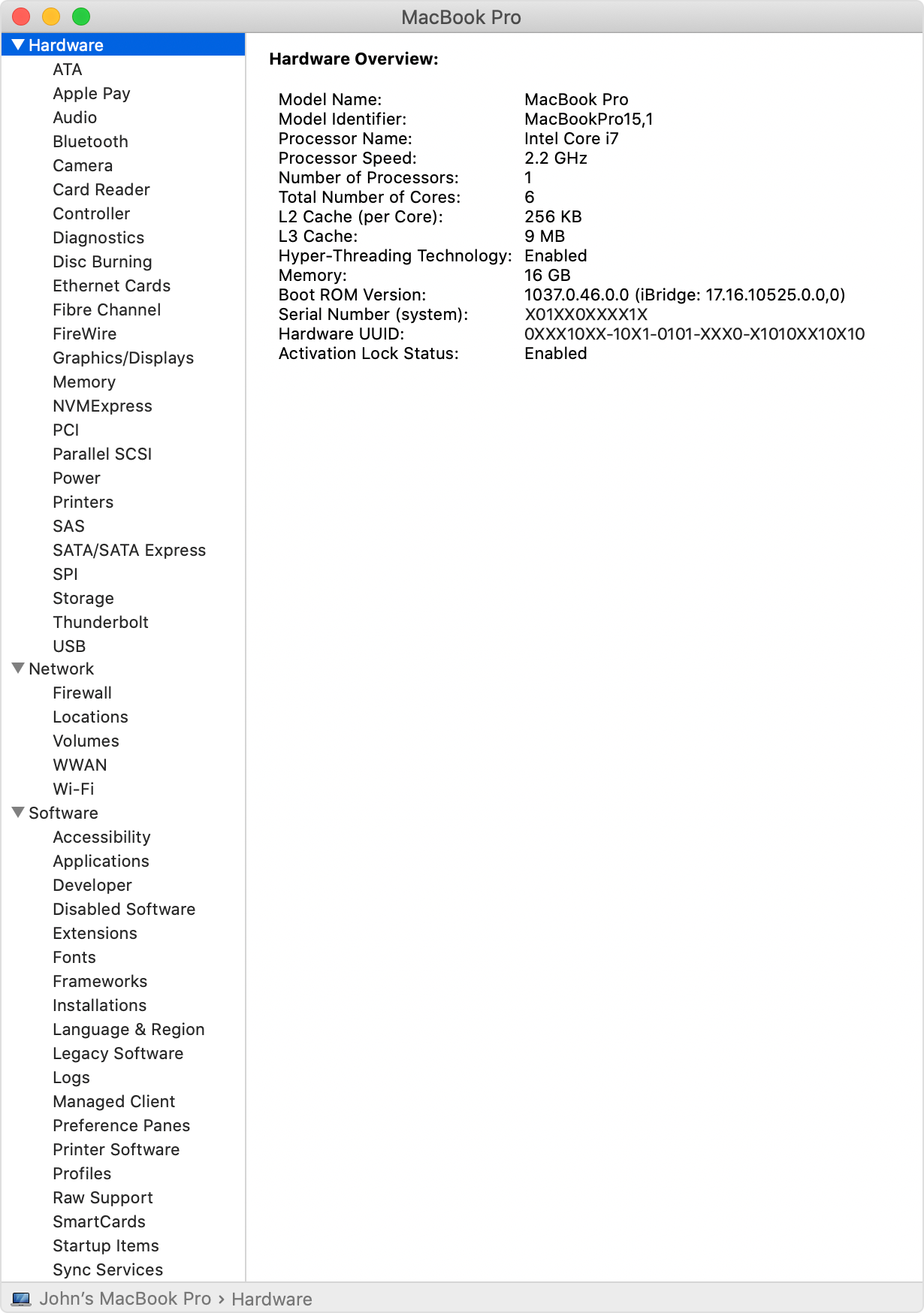The System Information app provides detailed specifications and other information about your Mac hardware and software, including your network and external devices. In some versions of OS X, this app is called System Profiler.
Choose Apple menu > About This Mac. This opens an overview of your Mac, including your Mac model, processor, memory, serial number, and version of macOS. To see the greater detail provided by the System Information app, click the System Report button.
To open System Information directly, press and hold the Option key and choose Apple menu > System Information. You can also use Spotlight to find System Information, or open it from the Utilities folder of your Applications folder.
Apple Mac Pro® 4,1 or later (Mac Pro® 6,1 or later recommended) Determine the model identifier by running the System Profiler application and inspecting the Hardware Overview page. The System Profiler can typically be found in the Utilities folder or it can be run using the following steps: 1. Click the 'About This Mac' option from the Apple.
Sql Profiler Download
- Speed up your app! NHibernate Profiler is a real-time visual debugger allowing a development team to gain valuable insight and perspective into their usage of NHibernate. The product is architected with input coming from many top industry leaders within the NHibernate community.
- I'm using High Sierra. I often have to copy & paste system information in a email or in a forum message. For this reason, I'd like a simple and easy way to get info on my operating system and my hardware at the command line. Currently I use $ systemprofiler foo.txt and then I search into foo.txt for the information I.
- Pinnacle Game Profiler by PowerUp Software is an application that was designed to allow you to map various mouse and keyboard actions to gamepads. Unfortunately, Pinnacle Game Profiler for Mac has not been released, but, you can download and install other tools that can perform similar tasks.
- The systemprofiler command can be run directly from single-user mode, by pressing CommandS when booting the Mac, without having to provide the fully qualified pathname, however depending on how much information you want from systemprofiler, you may need to pipe the output to more to less, etc., as scrolling in single-user mode is not as easy as from Terminal when booted to the Recovery HD.
Mac System Profiler Terminal
System Information opens to a system report for your Mac:
Select items in the sidebar to see information about each item. For example, the Hardware section shows your Mac serial number, the Memory section shows how much RAM is installed in each internal memory slot, and the Software section shows which startup disk (boot volume) your Mac is using. You can use the Network section and Network Utility to learn more about your network.
To have System Information read your serial number aloud, choose File > Speak Serial Number.
To save a copy of your system report, choose File > Save.
To learn more about System Information, choose Help > System Information Help.
A system profiler is a program that can provide detailed information about the software installed and hardware attached to a computer. Typically workstations and personal computers have had system profilers as a common feature since the mid-1990s.
However, system profilers exist on most computing architectures in some form or other. System Monitor programs in mainframes essentially provide the same function as system profiler programs on personal computers.
Modern system profilers typically provide real time information on not only the CPU state (such as clock speed), GPU state, and attached hardware state (such as USB or FireWire devices).
Historical origins[edit]
Apple System Profiler

System profilers came into use after punch cards were no longer needed to run programs. Mainframe computers had evolved into have modular architectures at the same time punch cards were being abandoned as input devices. Punch card based mainframe computer systems typically had very rigidly fixed architectures with little variation in input or output devices.
Since the 1990s hardware independent system profilers have emerged in some computing architectures, like Linux. Most Unix-like (aka POSIX compliant) operating systems have system hardware independent profilers.
Usage origin[edit]
In Apple Computer's classic Mac OS, this was done by an application called Apple System Profiler.
macOS' profiler is simply called System Information. In Microsoft Windows, some similar information may be found by getting properties on My Computer on the desktop.

List of system profiler software[edit]

Microsoft Windows[edit]
- System Information – built-in component
- CPU-Z – useful when overclocking processors
- System Information for Windows (SIW) – portable freeware with software, hardware, and network information as well as miscellaneous tools
- Belarc – freeware for personal use PC Auditing Software lists hardware, as well as software installed on the local machine and displays as a local webpage. Belarc also makes a security assessment for checking how secure a system is, and links missing updates directly to a Microsoft website for download.
- systeminfo – native windows command line, returns OS version, uptime, CPU, physical memory, network cards, etc.
- SekChek Local – an automated security audit tool which scans multiple Windows workstations and servers, from the network. It creates a security assessment report file which is presented as an Microsoft Access dataset.
- Speccy – detailed specifications of various PC subsystems
See also[edit]
